List of counties in Utah facts for kids
Quick facts for kids Counties of Utah |
|
|---|---|
| Location | State of Utah |
| Number | 29 |
| Populations | 992 (Daggett) – 1,185,813 (Salt Lake) |
| Areas | 299 square miles (770 km2) (Davis) – 7,820 square miles (20,300 km2) (San Juan) |
| Government | County government |
| Subdivisions | cities, towns, townships, unincorporated communities, Indian reservations, census designated places |
Utah is a state in the western United States, and like many other states, it is divided into smaller areas called counties. There are 29 counties in Utah today. These counties help organize the state and manage local services for people living there.
The first counties in Utah were created a long time ago, in 1849, when Utah was known as the provisional State of Deseret. Seven counties were formed then: Davis, Iron, Sanpete, Salt Lake, Tooele, Utah, and Weber.
When the Territory of Utah was officially created in 1851, the first government leaders re-established these original counties. They also added three new ones: Juab, Millard, and Washington. Most other counties were added between 1854 and 1894. The last two counties, Daggett and Duchesne, were created after Utah became a state.
For example, Duchesne County was formed in 1913. Before that, it was an Indian reservation that opened for settlers in 1905. Daggett County was created in 1917 because it was very hard for people living there to travel to the nearest county seat due to mountains and bad roads.
Utah's Counties: A Closer Look
Based on information from 2022, Utah's total population was about 3.4 million people. Most of these people, over 75%, live in just four counties along an area called the Wasatch Front. These counties are Salt Lake, Utah, Davis, and Weber.
Salt Lake County is the largest county by population, with over 1.1 million people. It is followed by Utah County (about 719,000 people), Davis County (about 373,000 people), and Weber County (about 271,000 people). The county with the fewest people is Daggett County, with only 992 residents.
When it comes to land size, San Juan County is the largest, covering about 7,821 square miles (20,260 km2). Davis County is the smallest, with an area of about 304 square miles (790 km2).
Understanding FIPS Codes
The United States government uses a special code called the Federal Information Processing Standard (FIPS) to identify each state and county. Utah's FIPS code is 49. When you see a county's FIPS code, it starts with 49, like 49XXX. These codes help keep track of information, such as census data, for each county.
How Counties Are Grouped
Utah's laws divide counties into six different groups based on their population. This helps the state government make rules that fit different types of areas, whether they are big cities or small rural towns.
- First class: These counties have 1,000,000 people or more. Only Salt Lake County is in this group.
- Second class: These counties have between 175,000 and 1,000,000 people. There are four counties in this group.
- Third class: These counties have between 40,000 and 175,000 people. Five counties belong here.
- Fourth class: These counties have between 11,000 and 40,000 people. Ten counties are in this group.
- Fifth class: These counties have between 4,000 and 11,000 people. Five counties are in this group.
- Sixth class: These counties have fewer than 4,000 people. Four counties are in this group.
These groups help lawmakers create specific rules for different areas. For example, a law meant to help smaller, more rural areas might apply only to counties in the fourth, fifth, and sixth classes.
How Counties Are Governed
Utah counties can choose one of four ways to run their local government. Most counties, 23 out of 29, are managed by a standard three-member commission. A commission is a group of people elected to make decisions for the county.
Other counties have chosen different ways to govern:
- Cache County was the first to change in 1988. It now has a seven-member council and an elected county mayor.
- Grand County started using a seven-member council with a manager chosen by the council in 1992.
- Morgan County and Wasatch County also adopted this type of government later.
- Salt Lake County changed in 2001 to a nine-member council with an elected mayor.
- Summit County adopted a five-member council with an appointed manager in 2006.
Contents
List of Utah Counties
Here is a list of all 29 counties in Utah, including when they were created, where their name comes from, and their population and area.
| County |
FIPS code | County seat | Est. | Origin | Etymology | Population | Area | Map |
|---|---|---|---|---|---|---|---|---|
| Beaver County | 001 | Beaver | January 5, 1856 | Part of Iron County | The many beavers in the area | 7,233 | 2,590 sq mi (6,708 km2) |
 |
| Box Elder County | 003 | Brigham City | January 5, 1856 | Part of Weber County | The many Box Elder trees in the area | 62,684 | 5,746 sq mi (14,882 km2) |
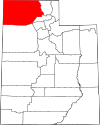 |
| Cache County | 005 | Logan | January 5, 1857 | Part of Weber County | Caches of furs made by Rocky Mountain Fur Company trappers | 142,393 | 1,165 sq mi (3,017 km2) |
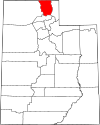 |
| Carbon County | 007 | Price | March 8, 1894 | Part of Emery County | The vast coal beds in the county | 20,609 | 1,478 sq mi (3,828 km2) |
 |
| Daggett County | 009 | Manila | January 7, 1918 | Part of Summit and Uintah counties | Ellsworth Daggett (1810–1880), the first Utah Surveyor General | 992 | 697 sq mi (1,805 km2) |
 |
| Davis County | 011 | Farmington | October 5, 1850 | Part of Deseret Great Salt Lake and Weber counties | Daniel C. Davis (1804–1850), Mormon Battalion captain | 373,207 | 299 sq mi (774 km2) |
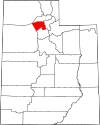 |
| Duchesne County | 013 | Duchesne | January 4, 1915 | Part of Wasatch County | Uncertain; likely origins are a Ute word translated "dark canyon", the French and Indian War site of Fort Duquesne (the county's initial settlement was also a fortress), the corrupted name of an area Indian chief, the name of Society of the Sacred Heart founder Rose Philippine Duchesne, the name of French geographer André Duchesne, or the name of French fur trapper and explorer Du Chasne | 20,477 | 3,241 sq mi (8,394 km2) |
 |
| Emery County | 015 | Castle Dale | February 12, 1880 | Part of Sanpete County | George W. Emery (1830–1909), Governor of the Utah Territory from 1875–1880 | 10,144 | 4,462 sq mi (11,557 km2) |
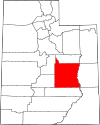 |
| Garfield County | 017 | Panguitch | March 9, 1882 | Part of Iron County | James A. Garfield (1831–1881), President of the United States in 1881 | 5,314 | 5,083 sq mi (13,165 km2) |
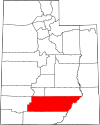 |
| Grand County | 019 | Moab | March 13, 1890 | Part of Emery County | The Grand River, since renamed to the Colorado River | 9,706 | 3,672 sq mi (9,510 km2) |
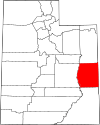 |
| Iron County | 021 | Parowan | January 31, 1850 | Original county of State of Deseret | Iron mines west of Cedar City | 64,211 | 3,297 sq mi (8,539 km2) |
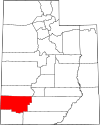 |
| Juab County | 023 | Nephi | March 3, 1852 | Original county of Territory of Utah | A Native American word translated "thirsty valley" or "flat plain" | 13,023 | 3,392 sq mi (8,785 km2) |
 |
| Kane County | 025 | Kanab | January 16, 1864 | Part of Washington County | Thomas L. Kane (1822–1883), U.S. Army officer who spoke in favor of the Mormon migration and settlement of Utah | 8,425 | 3,990 sq mi (10,334 km2) |
 |
| Millard County | 027 | Fillmore | October 4, 1851 | Original county of Territory of Utah | Millard Fillmore (1800–1874), President of the United States from 1850 to 1853 | 13,437 | 6,572 sq mi (17,021 km2) |
 |
| Morgan County | 029 | Morgan | January 17, 1862 | Part of Davis, Great Salt Lake, Summit, and Weber counties | Jedediah Morgan Grant (1816–1856), an Apostle of the Church of Jesus Christ of Latter-day Saints | 13,000 | 609 sq mi (1,577 km2) |
 |
| Piute County | 031 | Junction | January 16, 1865 | Part of Beaver County | The Piute tribe of Native Americans who lived in the area | 1,550 | 758 sq mi (1,963 km2) |
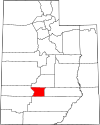 |
| Rich County | 033 | Randolph | January 16, 1864 | Part of Cache County | Charles C. Rich (1809–1883), an Apostle of The Church of Jesus Christ of Latter-day Saints | 2,670 | 1,029 sq mi (2,665 km2) |
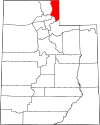 |
| Salt Lake County | 035 | Salt Lake City | January 31, 1850 | Original county of State of Deseret | The Great Salt Lake, the largest terminal lake in the Western Hemisphere | 1,185,813 | 742 sq mi (1,922 km2) |
 |
| San Juan County | 037 | Monticello | February 17, 1880 | Parts of Kane, Iron, and Piute counties | Named for the San Juan River, a 400-mile (640 km) tributary of the Colorado river located in southern Colorado and Utah | 14,358 | 7,820 sq mi (20,254 km2) |
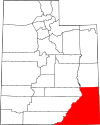 |
| Sanpete County | 039 | Manti | January 31, 1850 | Original county of State of Deseret | Uncertain, possibly from a Ute Chief named San Pitch | 30,277 | 1,590 sq mi (4,118 km2) |
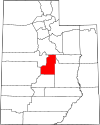 |
| Sevier County | 041 | Richfield | January 16, 1865 | Part of Sanpete County | The Sevier River, a 280-mile (450 km) river in central Utah | 22,344 | 1,911 sq mi (4,949 km2) |
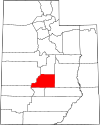 |
| Summit County | 043 | Coalville | January 13, 1854 | Part of Great Salt Lake and Green River counties | High elevations in the county, which includes 39 of Utah's highest peaks | 42,759 | 1,872 sq mi (4,848 km2) |
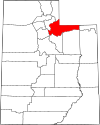 |
| Tooele County | 045 | Tooele | January 31, 1850 | Original county of State of Deseret | Uncertain, either from the Goshute Tribe Chief Tuilla or the Tules plant that grew in the marshes | 82,051 | 6,941 sq mi (17,977 km2) |
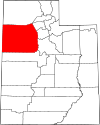 |
| Uintah County | 047 | Vernal | February 18, 1880 | Part of Sanpete, Summit, and Wasatch counties | The Uintah band of the Ute tribe who lived in the area | 37,747 | 4,480 sq mi (11,603 km2) |
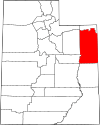 |
| Utah County | 049 | Provo | January 31, 1850 | Original county of State of Deseret | Yuta, the Spanish name for the Ute tribe | 719,174 | 2,003 sq mi (5,188 km2) |
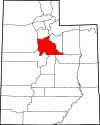 |
| Wasatch County | 051 | Heber City | January 17, 1862 | Part of Great Salt Lake, Green River, Sanpete, Summit, and Utah counties | A Native American word meaning "mountain pass", also the name of the Wasatch Range | 37,144 | 1,176 sq mi (3,046 km2) |
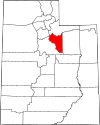 |
| Washington County | 053 | St. George | March 3, 1852 | Original county of Territory of Utah | George Washington (1732–1799), President of the United States from 1789 to 1797 | 202,452 | 2,426 sq mi (6,283 km2) |
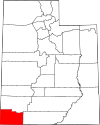 |
| Wayne County | 055 | Loa | March 10, 1892 | Part of Piute County | Wayne County, Tennessee | 2,614 | 2,461 sq mi (6,374 km2) |
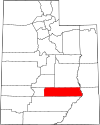 |
| Weber County | 057 | Ogden | January 31, 1850 | Original county of State of Deseret | The Weber River, a 125 miles (201 km) tributary of the Great Salt Lake | 271,926 | 576 sq mi (1,492 km2) |
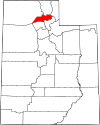 |
Original Counties of Deseret
These were the first counties established in the State of Deseret:
- Great Salt Lake County – created January 31, 1850
- Iron County – created January 31, 1850
- Sanpete County – created January 31, 1850
- Tuilla County – created January 31, 1850
- Utah County – created January 31, 1850
- Weber County – created January 31, 1850
- Davis County – created October 5, 1850, from parts of Great Salt Lake County and Weber County
County Name Changes Over Time
Some counties have changed their names since they were first created:
- Tuilla County, Deseret was formed on January 31, 1850. It was later renamed Tooele County, Utah Territory on March 3, 1852.
- Great Salt Lake County, Utah Territory was created on March 3, 1852. Its name changed to Salt Lake County, Utah Territory on January 29, 1868.
- Richland County, Utah Territory was created on January 16, 1854. It was renamed Rich County, Utah Territory on January 29, 1868.
Former Counties of Utah
Over time, ten counties that were once part of the Utah Territory were either absorbed into other states or became part of existing Utah counties.
| County | Established | Superseded | Etymology | Present location |
|---|---|---|---|---|
| Carson County | January 17, 1854 | March 2, 1861 | Named for Kit Carson, an American frontiersman | Nevada |
| Cedar County | January 5, 1856 | January 17, 1862 | Named for the numerous cedar trees growing in the area (which are actually juniper trees) | Utah County |
| Desert County | March 3, 1852 | January 17, 1862 | Named for the surrounding desert | Box Elder County, Tooele County and Nevada |
| Greasewood County | January 5, 1856 | January 17, 1862 | Named for the greasewood plant growing in the area | Box Elder County |
| Green River County | March 3, 1852 | February 16, 1872 | Named for the Green River, a 730-mile (1,170 km) tributary of the Colorado River that runs through Wyoming, Colorado and Utah | Cache, Weber, Morgan, Davis, Wasatch, Summit, Duchesne, Carbon, and Utah Counties, and Wyoming and Colorado |
| Humboldt County | January 5, 1856 | March 2, 1861 | Named for the Humboldt River, a 300-mile (480 km) river in Nevada and longest river in the Great Basin | Nevada |
| Malad County | January 5, 1856 | January 17, 1862 | Named for the Malad River, the name being French for "sickly" | Box Elder County |
| Rio Virgen County | February 18, 1869 | February 16, 1872 | Named for the Virgin River (el Rio de la Virgen), a 160-mile-long (260 km) tributary of the Colorado River located in southern Utah and Nevada | Washington County, Nevada and Arizona |
| St. Mary's County | January 5, 1856 | January 17, 1862 | Named after the Mary's River, which was later renamed to the Humboldt River | Nevada |
| Shambip County | January 12, 1856 | January 17, 1862 | Goshute Native American Tribe word for Rush Lake | Tooele County |
See also
 In Spanish: Anexo:Condados de Utah para niños
In Spanish: Anexo:Condados de Utah para niños



